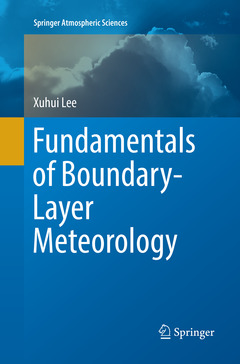Description
Fundamentals of Boundary-Layer Meteorology, Softcover reprint of the original 1st ed. 2018
Springer Atmospheric Sciences Series
Author: Lee Xuhui
Language: English
Subjects for Fundamentals of Boundary-Layer Meteorology:
Support: Print on demand
Description
/li>Contents
/li>Biography
/li>Comment
/li>
This textbook introduces a set of fundamental equations that govern the conservation of mass (dry air, water vapor, trace gas), momentum and energy in the lower atmosphere. Simplifications of each of these equations are made in the context of boundary-layer processes. Extended from these equations the author then discusses a key set of issues, including (1) turbulence generation and destruction, (2) force balances in various portions of the lower atmosphere, (3) canopy flow, (4) tracer diffusion and footprint theory, (5) principles of flux measurement and interpretation, (6) models for land evaporation, (7) models for surface temperature response to land use change, and (8) boundary layer budget calculations for heat, water vapor and carbon dioxide. Problem sets are supplied at the end of each chapter to reinforce the concepts and theory presented in the main text. This volume offers the accumulation of insights gained by the author during his academic career as a researcher and teacher in the field of boundary-layer meteorology.
Professor Lee is Sara Shallenberger Brown Professor of Meteorology at Yale University, USA. His research and teaching concern the interactions between the terrestrial biosphere, the atmosphere and anthropogenic drivers. His areas of interest include boundary-layer meteorology, air pollution meteorology, meteorological instrumentation, remote sensing, and carbon cycle science. One focus of his research is on greenhouse gas fluxes in the terrestrial environment, including forests, cropland and lakes. Other ongoing projects deal with isotopic tracers in the cycling of carbon dioxide and water vapor and biogeochemical and biophysical effects of land use on the climate system. He is recipient of the 2015 Award for Outstanding Achievement in Biometeorology from the American Meteorological Society and currently serves as editor-in-chief for the international journal Agricultural and Forest Meteorology.
Presents sets of questions and solutions based on fundamental governing equations
Examines micrometeorological phenomena over time and in isolation from atmospheric phenomena at larger scales. This scale-insolation approach is critically examined
Injects rigor to the field that so far has been mostly empirical in nature
Includes supplementary material: sn.pub/extras




